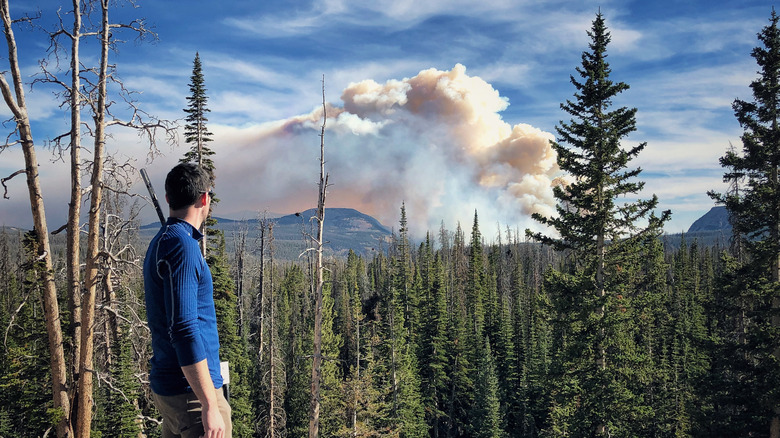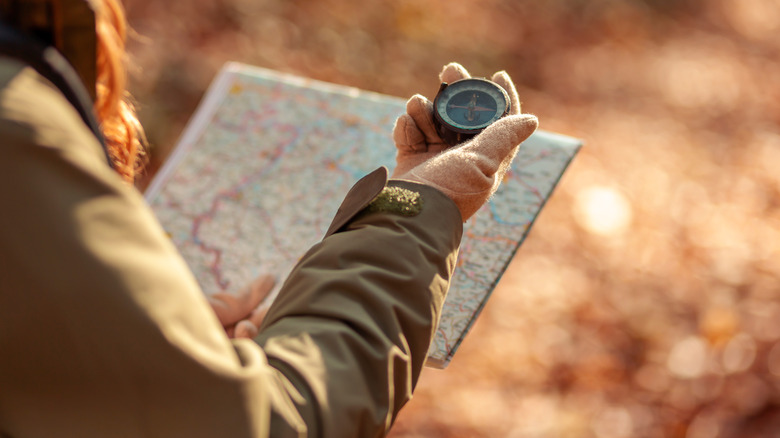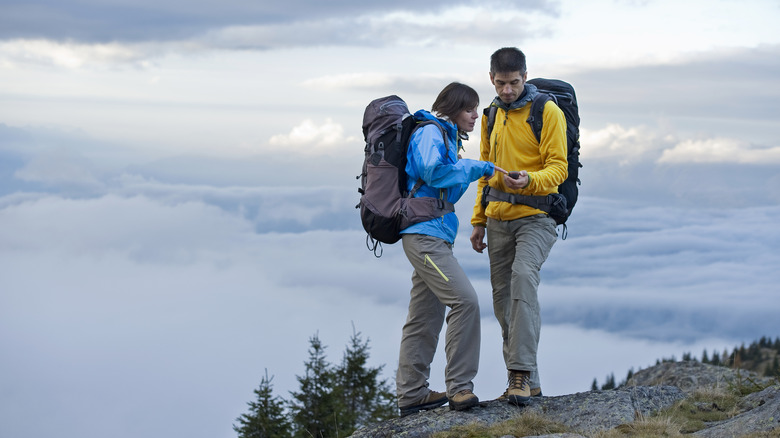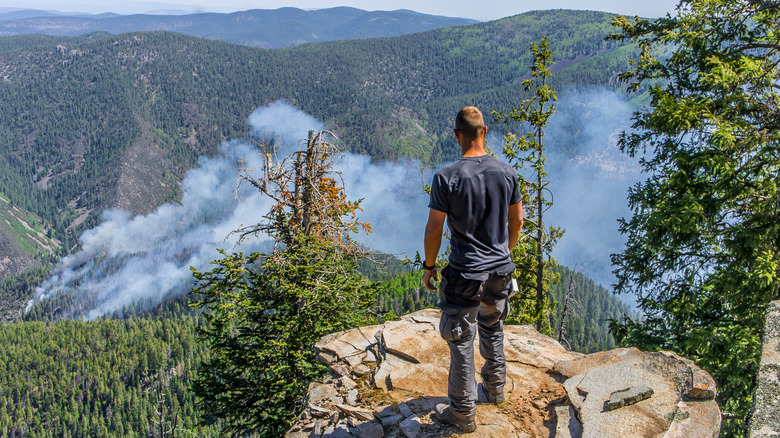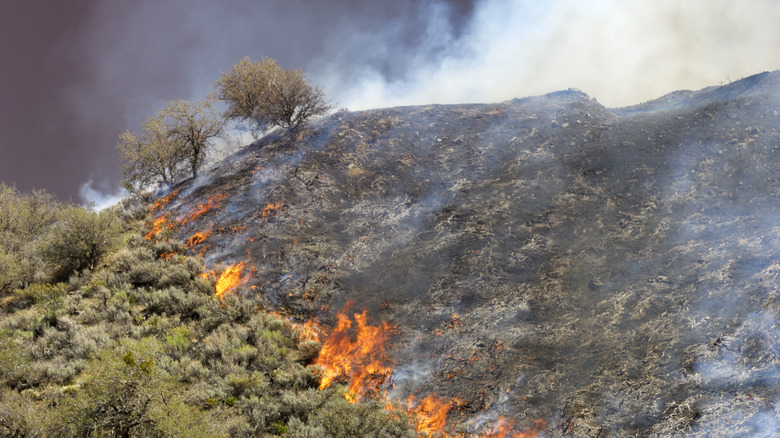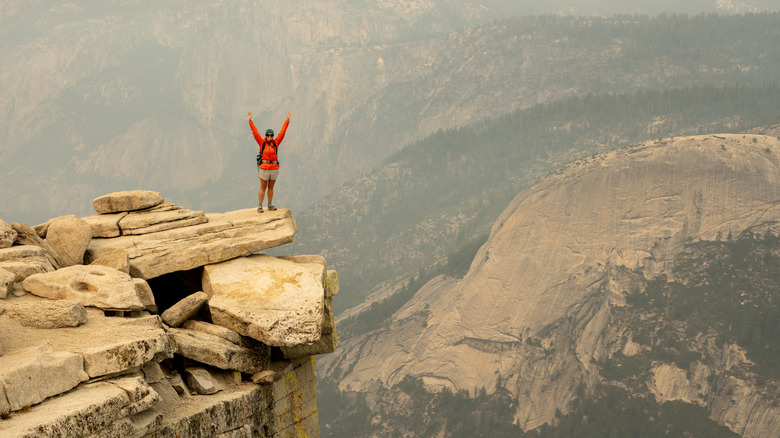What To Do If You Encounter Wildfire Smoke On A Hike
The summer and fall seasons are a beautiful time of year to go for a hike, with warmer temperatures and less chance of snow accumulation at higher altitudes. This time of year also coincides with what has traditionally been referred to as "fire season," when many wildfires take place in drier climates. In recent years, fire season has started to extend beyond these warmer months, and wildfires are now being battled throughout the rest of the year. As these events take place, it's become more important than ever to have a plan in place to prepare for the possibility of encountering wildfire smoke on a hike. This plan should include packing the right gear, understanding the landscape and how fire travels, and being flexible with your plans.
If you're on a hike and you see wildfire smoke in the distance, never assume that your location is completely out of harm's way. Smoke can spread and disseminate particles in the air more quickly than you realize, which can complicate breathing and incapacitate you in many ways. These microscopic particles create inflammation in the body, and they "are so small that they can get into the lungs and potentially the bloodstream," says Robert Laumbach, M.D., M.P.H., associate professor of Clinical Research and Occupational Medicine at the Rutgers School of Public Health, per Prevention. "They can have direct effects on the lungs—worsening of asthma, COPD, and increasing the risk of heart attack and stroke," Laumbach notes.
Prepare before you leave
The best way to prepare for the scenario of discovering wildfire smoke is to begin at home as you pack for your hike. As wildfires become more prevalent than ever before, it's better to anticipate the possibility of an encounter with a wildfire than simply to hope for the best. Begin by checking InciWeb to determine if there are any active wildfires taking place in the area where you're heading, followed by AirNow.gov to see what the current air quality conditions are. After you've considered which route you'll take, leave a copy of your trip itinerary with family or friends so that they'll be aware of your plans.
If you have trouble with asthma, don't forget to pack your inhaler, and bring an N-95 mask as well. Having an airtight mask is imperative to protect yourself from inhaling any smoke, and a simple cloth mask won't work as well in this situation. Wear hiking boots with thick soles to prepare for the event that you need to pass through any areas that have been burned. The heavy soles will protect your feet from the radiant heat rising from the scorched earth. A signal mirror is another item that will not take up much room in your pack, but it could be very useful for communication during an emergency. A paper map as well as a compass will be useful as well so that you're not dependent on your phone for direction.
Pack emergency gear
Another way to ensure your safety during a hike is to pack a satellite communication device. These types of devices will work even when your cell phone doesn't, because they operate by using satellite technology. This personal locator beacon from REI will transmit your location to the closest rescue agency that can assist you in the event of an emergency. This type of device also includes a strobe light, and it doesn't require a subscription fee for use. However, it doesn't offer two-way communication like this Garmin InReach, available at stores such as Amazon. This satellite communicator does require a subscription, but it provides tracking services as well as two-way texting. This device allows for loved ones at home to follow your location and alert you by text about any wildfire hazards they see developing. If you were to encounter a wildfire and needed assistance, pressing the SOS button on the InReach automatically transmits your location to rescue services and begins a two-way text with them as well.
You can also hear updates about potential wildfire activity by using a weather alert radio, such as this FosPower Emergency Weather Radio available on Amazon. This unit can be powered by battery or by hand crank. It delivers information on current weather conditions and emergency news updates, so you can stay aware of changing circumstances related to any wildfires nearby. In addition to the weather updates, this device includes a 1W flashlight and an SOS alarm.
Be flexible with your plans
With your emergency gear stowed away, it's time to enjoy your hike and appreciate the scenery of the route you've chosen. Always begin by signing the registry at the trailhead. Then as you make your way down the path, keep in mind that flexibility is essential when you're hiking during wildfire season. Never feel obligated to stick to your original plan, especially if you glimpse smoke from a fire in the distance. Hiking in these conditions is not only hazardous for your health, but the scenery will be obscured by the haziness in the air. It's a good idea to have alternate routes prepared, which will be useful if you encounter a trail closure or you need to change direction away from the smoke. Be aware of the exit routes on the trail as well, in case you need to reach safety quickly.
As you hike, take note of any part of the landscape that would provide safety if a wildfire came too close. Keep track of where ponds, streams, and lakes are located in the area. Also be aware of locations that have less vegetation, such as meadows or a field filled with large boulders or slabs of rock. These areas provide less fuel for a fire to consume, and they can provide an emergency refuge if absolutely necessary.
Understand how a wildfire spreads
It's helpful to understand how a wildfire progresses so that you can be prepared if you see one that is developing near the area where you're hiking. As Forbes reveals, fire can travel close to 6 mph in forests, and it moves more than double that speed on the grasslands. The embers from the flames can also travel great distances in the wind, sparking additional fires, which can even cross roads or bodies of water. These small fires are indicators that a larger fire is on the horizon, so be aware of these danger signs.
The flames from a wildfire tend to move faster uphill rather than downhill. For this reason, avoid hiking on top of a ridge near a wildfire where the flames could overtake you suddenly and without warning. Avoid hiking near chutes as well, which are ravines that run perpendicular to a ridge and can escalate the flames higher. A saddle is dangerous as well, where the fire can become concentrated where the land reaches its lowest point. Understanding the behavior of a wildfire and how quickly it can spread is another way of being prepared in the event that you are confronted with one.
Be prepared to end your hike early
Finally, if the situation arises where a fire develops close to you, consider ways that you can seek protection and escape the area. If the sky is turning orange and red, it's important to evacuate the area immediately. This is the time to remember the landmarks that you noticed before so that you can head for water, areas with little vegetation, or even sections of land that have already been burned. When there is little vegetation to attract the flames back again, there is less fuel for the fire, and these areas can provide a measure of safety for you.
Leave the trail at the nearest exit route, even if it's miles away from your car. Use your satellite communicator to signal for help, and put on your N-95 mask for protection from the smoke. A wet bandana around your face can provide additional protection, and a hat can keep the ash from falling in your eyes. Put on any bright clothing that you have to make it easier for rescuers to spot you, and use the SOS alarm on your weather radio. An encounter with wildfire smoke on a hike is always a possibility, but it shouldn't discourage you from taking that next trip. By being prepared and having the right mindset, the joy of being outdoors will always make your efforts worthwhile.
